Yamaha Synthesizers
YAMAHA CORPORATION
10-1 Nakazawa-cho Hamamatsu-city 430 JAPAN
TEL:+ 81 53 460 1111 FAX:+ 81 53 456 2798
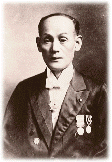
The founder, Torakusu Yamaha. 1887
The Japanese company Yamaha who also market furniture ,motor bikes, guitars,archery equipment, bathtubs, pianos, skis, tennis rackets and construction machinery amongst others came into the musical instrument market in 1900 with the construction of pianos for the Japanese market, their first electronic instrument the Electone D-1 electronic organ was designed and built in 1959. Early synthesizer products included the GX1 synthesizer, the CS-80 polyphonic synthesizer, the Cx5 digital music computer and the revolutionary DX7 digital synthesizer
The Yamaha GX1 synthesizer (1974)

The 2/3ton GX1 synthesizer
The GX1 was Yamaha's first polyphonic synthesizer although innovative for its time the instrument was out of the price range of most musicians selling for £30,000 in 1976, Yamaha sold very few models.
The CS-80 Synthesizer (1976)
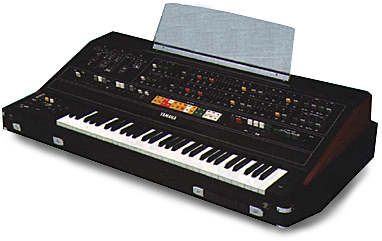
The Yamaha CS80 polyphonic Synthesizer
The Yamaha CS80 polyphonic Synthesizer was a development on the GX1 model at an affordable price range (£5,000 in 1976) and competing with several other early polyphonic synthesizers such as the ARP Omni and the Moog Polymoog. The CS80 was a complex polyphonic synthesizer with 16 oscillators, 32 filters, 32 envelopes allowing voices to be split and layered and stored in a six part memory allocation. The keyboard was velocity sensitive with poly-aftertouch sensitivity.
The Yamaha CX5 Music Computer
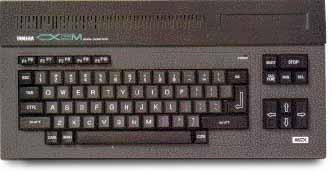
A Yamaha CX5 minus the VDU unit
The CX5 music computer was an FM multi-timbral digital synthesizer controlled by a keyboard and VDU . The synthesizer was edited on the VDU screen using the CX5's proprietary software, programs included composition software for multi-timbral sequencing and notation, FM voicing of the internal synthesizer, DX7 VOICING software for programming and manipulating patches in the DX7 synthesizer and more. Since the CX5M is completely MSX compatible, word processing, spread sheets, games and other general purpose computer programs are possible. At the time the CX5 was the only affordable computer synthesizer on the market.
The DX7 Synthesizer and DX range
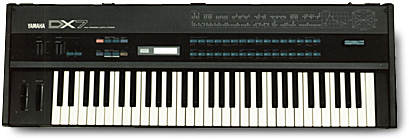
The Yamaha DX7 mkII Synthesizer 1983
The DX7 synthesizer was the first truly digital synthesizer and was released with great commercial success in 1983, selling over 180,000 units. The DX7 used a type of synthesis Yamaha called "Frequency Modulation" developed by Professor John Chowning at Stanford University in the 1970s. In FM synthesis sounds are created by interacting units known as 'operators', which can act as 'carriers' or 'modulators'. Each one is a sine wave that can be shaped and given its own pitch. When connected, one modulates the sound of the other to produce a new pitch and tone. The arrangement of operators and their relative pitches determines the final timbre produced. The DX7 has six operators that can be placed in 32 arrangements ('algorithms'). There's a also host of other parameters and a complex envelope that has two values for each point.
The LCD input controls of the DX7 appeared daunting to most keyboard players used to traditional analogue sliders and knobs. Most users only touched the surface of the synthesis possibilities of the DX7, instead relying on a series of sound card cartridges marketed by Yamaha to overcome the programming complexity.
The DX7 was one of the first synths with a full complement of MIDI ports. It also has a unique breath controller input port. This device allowed the user to manipulated the instruments timbre using breath pressure via a mouth held tube. The DX7 has 16-note polyphony, a 61-note velocity and an aftertouch-sensing keyboard, 32 onboard memories, additional cartridge memory and monophonic output.
The Yamaha DX Range
- GS-1 and GS-2; Early piano style FM synthesis instruments.
- Yamaha DX1: a double DX7 with a wooden case, piano keys and easier programming.
- Yamaha DX5 digital synthesizer. The DX5 has many of the features found on the DX1 but is more affordable. The DX5 was basically 2 DX7's with features that include: 32 patches x 2, 64 performance memories, 16 note polyphonic per channel, dual rom/ram slots, low Z or high Z outputs, extended keyboard note scaling, 76 key velocity & a touch sensitive keyboard.
- DX7.Yamaha's best selling FM synthesizer
- TX7. the TX7 was a modular (rackmounted) version of the DX7
- Yamaha DX9. The DX9 has
the same FM digital sound generation capability as the DX7, but with
4 operators and a choice of 8 algorithms. The DX9 has a 16-note polyphonic
keyboard and is supplied with 420 pre-programmed voices on an external
data cassette tape. Newly programmed voices can be saved on cassette
tape to build up a personal voice library.
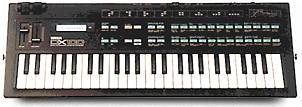
The Yamaha DX100 synthesizer
- Yamaha DX 21, 27 and 100. The Yamaha DX27, DX27S, and DX100 were the low end versions of the professional Yamaha synthesizers -the DX7. They had smaller 61 note non velocity sensitive keyboards. The sound source was a 4 operator, 8 algorithm FM Tone Generator that could give 8 note polyphony. The DX21,27,and 100 were basically the same machine with slight variations of effects and portability.
- Yamaha DX7II: an updated DX7
- DX11 and TX81Z. Yamaha added more waveforms and multitimbrality for the DX11 and TX81Z, these instruments eventually became the prototypes for the recent SY77 and 99.
- TX816.The TX816 is eight rack-mounted DX7 modules together in one casing.
copyright notice:
parts of this site have been taken from: http://www.obsolete.com/120_years/machines/yamaha